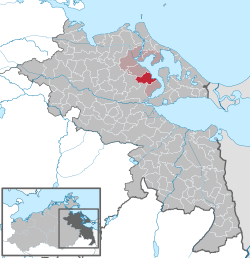
Pomerania is a historical region on the southern shore of the Baltic Sea in Central Europe, split between Poland and Germany. The central and eastern part belongs to the West Pomeranian, Pomeranian and Kuyavian-Pomeranian voivodeships of Poland, while the western part belongs to the German states of Mecklenburg-Western Pomerania and Brandenburg.

Mecklenburg-Vorpommern ; also known by its anglicized name Mecklenburg–Western Pomerania, is a state in the north-east of Germany. Of the country's sixteen states, Mecklenburg-Vorpommern ranks 14th in population; it covers an area of 23,213 km2 (8,963 sq mi), making it the sixth largest German state in area; and it is 16th in population density. Schwerin is the state capital and Rostock is the largest city. Other major cities include Neubrandenburg, Stralsund, Greifswald, Wismar, and Güstrow. It was named after the two regions of Mecklenburg and Vorpommern, and its name means the "nearer part of Pomerania", with the rest now lying in Poland.

Ostvorpommern was a Kreis (district) in the eastern part of Mecklenburg-Western Pomerania, Germany. Neighboring districts were Uecker-Randow, Mecklenburg-Strelitz, Demmin and Nordvorpommern. The Hanseatic city of Greifswald was enclosed by the district, but did not belong to it.
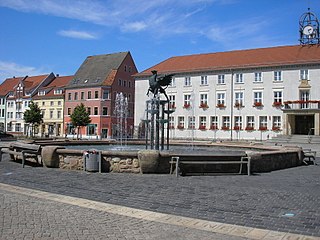
Anklam, formerly known as Tanglim and Wendenburg, is a town in the Western Pomerania region of Mecklenburg-Vorpommern in north-eastern Germany. It is situated on the banks of the Peene river, just 8 km from its mouth in the Kleines Haff, the western part of the Szczecin Lagoon. Anklam has a population of 12,177 (2021) and was the capital of the former Ostvorpommern district. Since September 2011, it has been part of the district of Vorpommern-Greifswald.

The Bay of Pomerania is a basin in the southwestern Baltic Sea, off the Pomeranian shores of Poland and Germany. It stretches between the northernmost tip of the island of Rugia called Gellort northwest of Cape Arkona in the west, and the village of Jarosławiec in the east. In the south, it is bounded by the islands of Usedom/Uznam and Wolin, which separate it from the Szczecin Lagoon which is flown through by the Oder River, and is connected to the bay by three straits, the Dziwna, Świna, and Peenestrom.
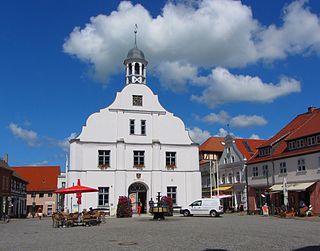
Wolgast is a town in the district of Vorpommern-Greifswald, in Mecklenburg-Vorpommern, Germany. It is situated on the bank of the river Peenestrom, vis-a-vis the island of Usedom on the Baltic coast that can be accessed by road and railway via a movable bascule bridge. In December 2004, the town had a population of 12,725.

Lubmin is a coastal resort in the German state of Mecklenburg-Vorpommern. Lubmin is situated near Greifswald and on the Bay of Greifswald.

Usedom is a town on Usedom Island, in the Vorpommern-Greifswald district in Mecklenburg-Vorpommern, in north-eastern Germany, close to the border with Poland. It is the seat of the Amt Usedom-Süd, to which 14 other communities also belong.

Gützkow is a town in the District of Vorpommern-Greifswald in Mecklenburg-Vorpommern, in north-eastern Germany. It is situated some 15 kilometres (9.3 mi) south of Greifswald, on the north bank of the River Peene. Gützkow was the central town of the medieval County of Gützkow.

Jarmen is a town in the Vorpommern-Greifswald district, in Mecklenburg-Western Pomerania, Germany. It is situated on the southern bank of the river Peene, 20 km south of Greifswald, in the historic region of Pomerania.

Bargischow is a municipality in the Vorpommern-Greifswald district, in Mecklenburg-Vorpommern, Germany.
The Amt am Peenestrom is an Amt in the district of Vorpommern-Greifswald, in Mecklenburg-Vorpommern, Germany. The seat of the Amt is in Wolgast.

Pomerania during the Late Middle Ages covers the history of Pomerania in the 14th and 15th centuries.

Philipp Julius was duke of Pomerania in the Teilherzogtum Pomerania-Wolgast from 1592 to 1625.
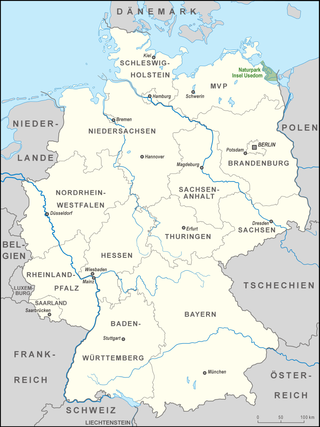
The Usedom Island Nature Park comprises the German part of the island of Usedom in the district of Vorpommern-Greifswald in the state of Mecklenburg-Vorpommern, Germany. In addition to the island itself, the park covers the waterbody between the island and the mainland as well as small strips of mainland in the northwest and west near the seaside resorts of Lubmin and the town of Lassan.
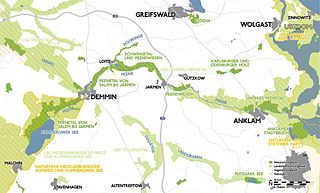
The Peene Valley is a landscape in West Pomerania in the German state of Mecklenburg-Vorpommern. It covers the area on either side of the river Peene in the districts of Mecklenburgische Seenplatte and Vorpommern-Greifswald as the river makes its way from Lake Kummerow past the towns of Dargun, Demmin, Loitz, Jarmen, Gützkow and Anklam to its mouth on the Peenestrom.

The Region of Stralsund belonged to the Prussian Province of Pomerania and existed from 1818 to 1932.

Historical Western Pomerania, also called Cispomerania,Fore Pomerania, Front Pomerania or Hither Pomerania, is the western extremity of the historic region of Pomerania forming the southern coast of the Baltic Sea, located mostly in north-eastern Germany, with a small portion in north-western Poland.
The Wars of the Rügen Succession were two early 14th century conflicts fought primarily between Mecklenburg and Pomerania for control of the Danish Principality of Rügen on the southern Baltic Sea coast.
Christian Thomsen Carl, Christian Thomasen Carl, Christian Thomæsen Carl, Christian Thomesen Carl, Christen Thomasen Carl or Christen Thomesen Carl, in German tradition Carlson or Karlson, rarely Carlsen was a Danish naval officer. He is known not only for his military career, but also for saving the town council's archives in Greifswald as well as the whole town of Anklam from being burned during the Great Northern War.


